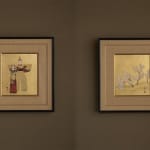Hishida Shunsō (1874−1911)
Hina Dolls and Cherry Blossoms
Color on paper, framed
On kojikishi paper
With a Tokyo Art Club certificate (each), box authentication by Hishida Haruo (each)
Seal: Shunso (each)
21.1 x 18.1 cm each
38 x 34.7 cm each (overall)
On kojikishi paper
With a Tokyo Art Club certificate (each), box authentication by Hishida Haruo (each)
Seal: Shunso (each)
21.1 x 18.1 cm each
38 x 34.7 cm each (overall)
Further images
-
(View a larger image of thumbnail 1
)

-
(View a larger image of thumbnail 2
)

-
(View a larger image of thumbnail 3
)

-
(View a larger image of thumbnail 4
)

-
(View a larger image of thumbnail 5
)

-
(View a larger image of thumbnail 6
)

-
(View a larger image of thumbnail 7
)

-
(View a larger image of thumbnail 8
)

Literature
Hishida Shunso zoku. Tokyo: Dai Nihon Kaiga Kogei Bijutsu, 1978.
This pair of works depicts hina dolls on the left painting and cherry blossoms on the right, both of which are features of the mid-spring theme, on kojikishi (literally, mini colored paper). The paintings are done on gold ground, which generates variable visual effects depending on the beholder’s different viewing angles, particularly with features such as the hills and the sky in the background of the cherry blossoms painting. Unfortunately, this effect can hardly be experienced with printed copy of the work. Compared to the size of shikishi nowadays which usually measures 27.3 x 24.2 cm, these kojikishi are of miniature size common at Shunso’s time, which bring up a sense of delicacy responding to the subjects. Although both paintings depict the spring-related themes, each stands as an individual work. Nevertheless, the two paintings comprise a rather decent pair, even if they were not meant to be so.
In 1906, with the relocation of Japan Art Institute to Izura, Ibaraki Prefecture, artists and figures such as Shunso himself, Okakura Tenshin, Yokoyama Taikan, Shimomura Kanzan, and Kimura Buzan all moved there with their families. In 1908, Shunso moved to Yoyogi in Tokyo for medical treatment to his eyes. In the following year, he completed Fallen Leaves depicting the woods near Yoyogi, which came to be recognized as his lifelong signature masterpiece and later designated as an Important Cultural Property. Despite his poor eye condition, during that year Shunso nearly painted one work every three days. The present works were completed in the same year of 1909, the very latest years of his artistic career. No matter one is a Shunso collector or not, he should appreciate its refinement.
Hishida Shunso (nihonga painter; 1874−1911)
Nagano-born nihonga painter. His real name is Mioji. Studied under Hashimoto Gaho at the Tokyo School of Fine Arts. Became a teacher of the school after his graduation. Known as one of the elite four disciples of Gaho together with Yokoyama Taikan, Shimomura Kanzan, and Kimura Buzan. Contributed to the modernization of nihonga with a technique of depiction without lines, called moro-tai (“hazy style”).
In 1906, with the relocation of Japan Art Institute to Izura, Ibaraki Prefecture, artists and figures such as Shunso himself, Okakura Tenshin, Yokoyama Taikan, Shimomura Kanzan, and Kimura Buzan all moved there with their families. In 1908, Shunso moved to Yoyogi in Tokyo for medical treatment to his eyes. In the following year, he completed Fallen Leaves depicting the woods near Yoyogi, which came to be recognized as his lifelong signature masterpiece and later designated as an Important Cultural Property. Despite his poor eye condition, during that year Shunso nearly painted one work every three days. The present works were completed in the same year of 1909, the very latest years of his artistic career. No matter one is a Shunso collector or not, he should appreciate its refinement.
Hishida Shunso (nihonga painter; 1874−1911)
Nagano-born nihonga painter. His real name is Mioji. Studied under Hashimoto Gaho at the Tokyo School of Fine Arts. Became a teacher of the school after his graduation. Known as one of the elite four disciples of Gaho together with Yokoyama Taikan, Shimomura Kanzan, and Kimura Buzan. Contributed to the modernization of nihonga with a technique of depiction without lines, called moro-tai (“hazy style”).







